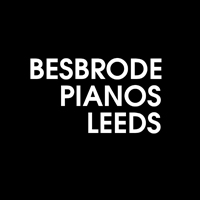Anthony Holbrook
Born in 1927 in Birmingham, Holbrook's journey through the arts began early, leading to a career as a teacher, he worked for 40 years as Head of the Art Department at Bradford Grammar School, with a passion for creating early keyboard instruments in his free time. Over several decades, Holbrook hand-built a number of virginals, clavichords, and harpsichords, all designed and constructed from raw materials based on his extensive research of historical instruments.
Holbrook's artistic talents were broad and varied. He was a painter who worked in diverse media, a sculptor proficient in a range of materials, and an avid photographer who maintained a fullyequipped darkroom. However, it was his passion for music and a deep curiosity about early keyboard instruments that led him to an entirely new realm of creation: the building of harpsichords.
This journey began in 1952, when Holbrook utilising his self-taught carpentry skills, decided to build his first instrument. What started as an extension of his furniture making hobby soon became a lifelong pursuit. Over the next several decades, Holbrook would go on to
design and construct a number of virginals, clavichords and harpsichords, each meticulously crafted from sought-after raw materials and based on his extensive research of historical instruments. Holbrook's process was as rigorous as it was inventive. Without readily available plans, Frank Hubbard did not publish his authoritative book "Three Centuries of Harpsichord Making" until 1965, he would visit museums like the Victoria and Albert Museum in London, the Russell Collection in Edinburgh or Fenton House in London to study key instruments first-hand. Sometimes, when curators permitted, he would take measurements or photographs, but often he had to rely on his observations and instincts to devise his own plans and calculations. His goal was never simply to replicate these historical instruments but to improve upon them, aspiring to match or even surpass the craftsmanship of venerable makers like Kirckman, Taskin, Ruckers and Hubert.
"Anthony admired craftsmanship perhaps more than the creation of art itself," recalls his widow, Niki Holbrook. "He was always thrilled when an instrument reached the stage where it could make its first sounds. That was when all the painstaking work became truly
worthwhile."
Despite the immense effort involved, which often required him to work for several hours each day after teaching, Holbrook never sought to commercialise nor exhibit his creations. The completion of each instrument was an end in itself, a fulfilment of his own high standards, design process and artistic vision. He did, however, build two instruments on commission, both in the French style, and he even bought back one of his harpsichords when its owner moved to a smaller house, preferring to keep it rather than see it sold elsewhere.He built a Harpsichord for Professor of Music Frank Mumby at Leeds University (now in use at Pembroke College, Cambridge) and restored a Harpsichord for Alistair Lawrence famed Harpsichord specialist. The instrument can be seen at Farnley Hall just outside of Otley.
Growing up, music was a mainstay within the Holbrook home. "Chamber music gatherings and string quartets, were a regular occurrence," recollects Anthony's son, Gabriel. Anthony was a keen cellist and keyboard player and would practise solo works by
Fitzwilliam, Scarlatti, Couperin, Handel and Bach. "Anthony's work was driven by a love of both art and music," Niki Holbrook adds. "He believed that the two were inseparable, that the beauty of an instrument was as important as its sound. Each piece he created was a labour of love, a fusion of his talents as an artist and a musician, he had his own beautiful world."
Running to the end of September, this exhibition offers a rare glimpse into this world, celebrating the evolution of the keyboard instrument. Those who visit will not only have the first opportunity to view this collection of remarkable instruments but also to reflect on the legacy of a man whose work continues to inspire and resonate.
Melvin Besbrode of Besbrode Pianos said, "It is wonderful Niki has decided to exhibit Anthony's beloved Harpsichords. Without her decision to come forward these extraordinary instruments may have never come to light. For those who appreciate the finer things in life - whether art, music, or the sheer beauty of expertly crafted objects - this exhibition in our sale room is not to be missed. It is a salute to the rich cultural heritage of Yorkshire and a fitting tribute to a man whose life was devoted to the pursuit of excellence in all its forms."
Event Details
Venue: Floor 2 of Besbrode Pianos showroom directly behind the piano shop on Holbeck Lane
Address: Besbrode Pianos, Unit A, Holbeck New Mills, Braithwaite Street, Leeds, LS119XE
Tel: 0113 2448344
Free Parking: Free parking is available behind our piano shop. Turn onto Braithwaite Street and take an immediate left into the yard. Look for signage.
Free Entry: Entrance into this event is free. There is no need to book.
Accessibility: The exhibition takes place on the second floor of our main showroom. Please be advised we only have stair access to the event.







